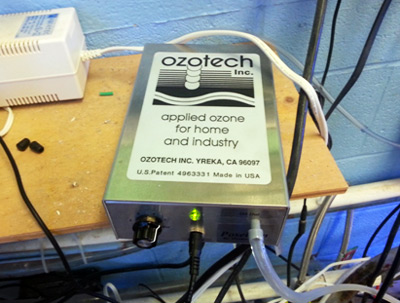The use of ozone in home aquaria is far from a new idea. In fact, 20+ years ago, ozone was commonly used by both public aquaria and hobbyists alike. I experimented with the use of ozone on my classroom system a little over a decade ago. However, the system I invested in was of very poor quality. We had two probes fail in less than a year, and the monitor indicated that our generator had also failed to continue to generate the gas. Needless to say, I dropped out of ozone, having experienced mixed results at best.
Fast forward to three years ago. My students and I added a mangrove-swamp-themed aquarium to our reef display system. As the mangroves began to grow and macroalgae filled the spaces between their roots, we noticed a decline in water clarity in our reef display. The decline was, by no means, massive, yet it was certainly noticeable. After careful research and communication with several public aquaria, we found ourselves once again considering the use of ozone on our system.

For the remainder of this article and in two future installments, my students and I will share our reasoning and research regarding our decision to add ozone and our short-term results. In this installment, we’ll identify what ozone is and what we hoped to achieve in adding it to our system. Installment two will delve into how we selected our system and how we are using ozone. The final installment will focus on how to stay safe while using ozone and why it may not be the best option for every application.
Ozone defined
So what is ozone? Ozone (O3), a form of the element oxygen, is most commonly created when intense electrical discharges occur (lightning strikes to you and me). The chemical nature of the molecule allows it to accumulate in our upper atmosphere, but we also create ozone as a pollutant at the surface where it can become an unwelcome part of smog.
Why add ozone to aquaria?

If ozone is a toxic part of smog, why in the world would we add it to our aquaria? The short answer is that in small, controlled doses, ozone has the potential to be quite helpful. In our case, we were focused on water clarity and discoloration. Ozone excels at breaking down the organic molecules responsible for tinting and fouling our water. Within days of adding ozone, our water was noticeably clearer—so much so that we actually had some corals experience minor bleaching.
A secondary benefit has been a reduction of cyanobacteria. This was not expected, and we are not completely certain we can credit ozone alone for this outcome, as the aquarium is far more complex than most of us would ever imagine. Nevertheless, the few red, gooey patches we had are largely gone.
The sterilization myth
Ozone also has—or had in the past—a plethora of false claims of benefit. The most common myth regarding the use of ozone in the home aquarium is that it will sterilize the water. When we think more carefully about this claim, it makes no sense at all. If the water were truly sterile, nothing would remain alive. The very low doses recommended by aquarium chemists are far too low to kill most kinds of bacteria or deactivate all viruses. Bacteria cells that directly contact ozone are killed, but the masses remain generally unaltered. In other words, your good bacteria are not seriously threatened by adding ozone. It also means that ozone alone will not rid your tank of a pathogenic disease outbreak.
Tune in for part 2!
In our next installment, we’ll look at how we use ozone and how we selected our system (Clearing the Air on Ozone: Part 2).
Photo credit: David Bowers



